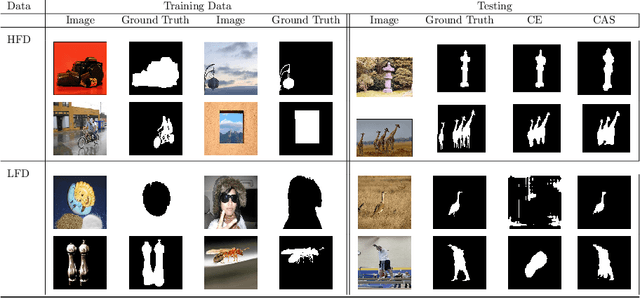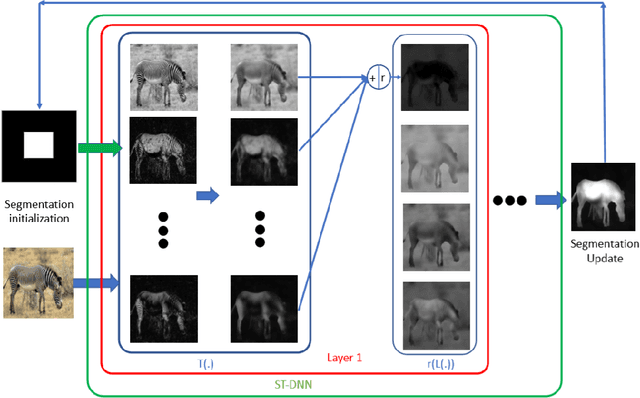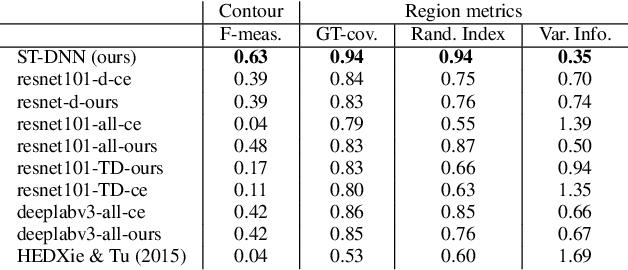Angira Sharma
Class-Agnostic Segmentation Loss and Its Application to Salient Object Detection and Segmentation
Jul 16, 2021



Abstract:In this paper we present a novel loss function, called class-agnostic segmentation (CAS) loss. With CAS loss the class descriptors are learned during training of the network. We don't require to define the label of a class a-priori, rather the CAS loss clusters regions with similar appearance together in a weakly-supervised manner. Furthermore, we show that the CAS loss function is sparse, bounded, and robust to class-imbalance. We first apply our CAS loss function with fully-convolutional ResNet101 and DeepLab-v3 architectures to the binary segmentation problem of salient object detection. We investigate the performance against the state-of-the-art methods in two settings of low and high-fidelity training data on seven salient object detection datasets. For low-fidelity training data (incorrect class label) class-agnostic segmentation loss outperforms the state-of-the-art methods on salient object detection datasets by staggering margins of around 50%. For high-fidelity training data (correct class labels) class-agnostic segmentation models perform as good as the state-of-the-art approaches while beating the state-of-the-art methods on most datasets. In order to show the utility of the loss function across different domains we then also test on general segmentation dataset, where class-agnostic segmentation loss outperforms competing losses by huge margins.
Shape-Tailored Deep Neural Networks
Feb 16, 2021



Abstract:We present Shape-Tailored Deep Neural Networks (ST-DNN). ST-DNN extend convolutional networks (CNN), which aggregate data from fixed shape (square) neighborhoods, to compute descriptors defined on arbitrarily shaped regions. This is natural for segmentation, where descriptors should describe regions (e.g., of objects) that have diverse shape. We formulate these descriptors through the Poisson partial differential equation (PDE), which can be used to generalize convolution to arbitrary regions. We stack multiple PDE layers to generalize a deep CNN to arbitrary regions, and apply it to segmentation. We show that ST-DNN are covariant to translations and rotations and robust to domain deformations, natural for segmentation, which existing CNN based methods lack. ST-DNN are 3-4 orders of magnitude smaller then CNNs used for segmentation. We show that they exceed segmentation performance compared to state-of-the-art CNN-based descriptors using 2-3 orders smaller training sets on the texture segmentation problem.
Digital Twins: State of the Art Theory and Practice, Challenges, and Open Research Questions
Nov 06, 2020

Abstract:Digital Twin was introduced over a decade ago, as an innovative all-encompassing tool, with perceived benefits including real-time monitoring, simulation and forecasting. However, the theoretical framework and practical implementations of digital twins (DT) are still far from this vision. Although successful implementations exist, sufficient implementation details are not publicly available, therefore it is difficult to assess their effectiveness, draw comparisons and jointly advance the DT methodology. This work explores the various DT features and current approaches, the shortcomings and reasons behind the delay in the implementation and adoption of digital twin. Advancements in machine learning, internet of things and big data have contributed hugely to the improvements in DT with regards to its real-time monitoring and forecasting properties. Despite this progress and individual company-based efforts, certain research gaps exist in the field, which have caused delay in the widespread adoption of this concept. We reviewed relevant works and identified that the major reasons for this delay are the lack of a universal reference framework, domain dependence, security concerns of shared data, reliance of digital twin on other technologies, and lack of quantitative metrics. We define the necessary components of a digital twin required for a universal reference framework, which also validate its uniqueness as a concept compared to similar concepts like simulation, autonomous systems, etc. This work further assesses the digital twin applications in different domains and the current state of machine learning and big data in it. It thus answers and identifies novel research questions, both of which will help to better understand and advance the theory and practice of digital twins.
 Add to Chrome
Add to Chrome Add to Firefox
Add to Firefox Add to Edge
Add to Edge